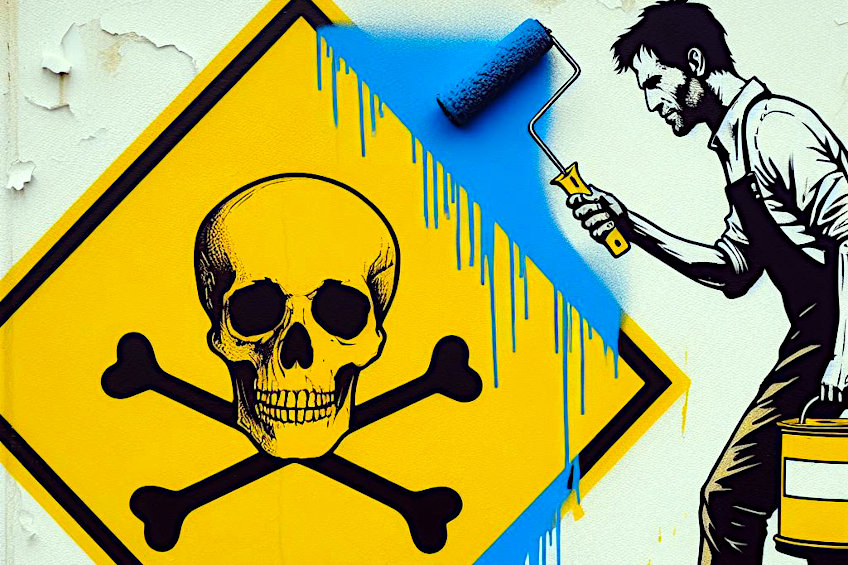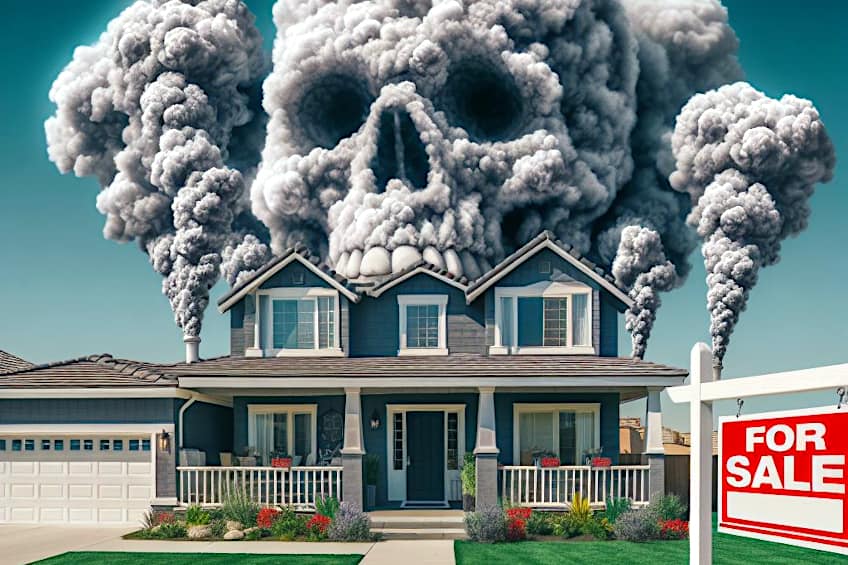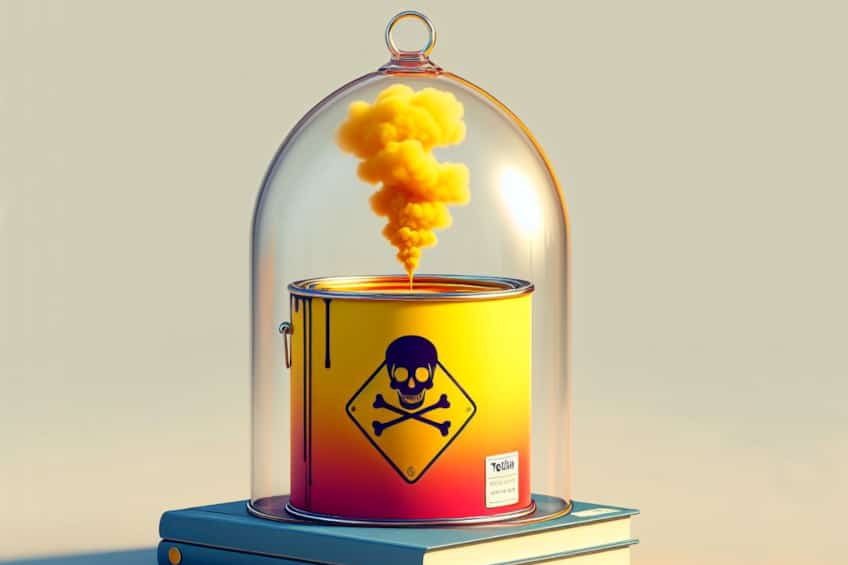Can You Paint Over Lead Paint? – Leaded Coating Safety Guide
This post may contain affiliate links. We may earn a small commission from purchases made through them, at no additional cost to you. You help to support resin-expert.com
Covering lead paint might seem like the only safe way of dealing with old lead paint that can be very dangerous. Naturally, the condition of the lead paint is an important factor that needs to be considered, as this will determine your way forward. However, there is a lot more that goes into this task if you are wondering, “can you paint over lead paint?”. So, let’s find out how you can deal with this paint in the safest way possible.
Table of Contents
Can You Paint Over Lead Paint?
If you are thinking about painting over lead paint, you need to consider the state of the paint as well as the surface it is on. Only when lead-based paint is damaged or decaying does it provide an immediate concern. This includes releasing hazardous lead particles and harmful fumes when inhaled.
Painting over lead paint is safe as long as the paint is in excellent condition, if you are wearing suitable protection, and the method of painting does not disrupt the state of the lead paint. This is defined as any activity that breaks down, modifies, or affects the lead-based paint.
Safety Concerns Regarding Lead Paint
To begin, we need to warn you that lead-based paint is hazardous. Wear a respirator, protective gloves, safety glasses, and coveralls whenever you deal with lead paint, regardless of whether it is in excellent or terrible condition. Lead paint is a kind of paint that includes the heavy metal lead.
Leaded paint was commonly utilized in considerably older or historic properties built prior to 1978.
Manufacturers used several lead compounds as pigments in their paint, most commonly to produce a bright white. Lead also improved the paint’s durability, resistance to moisture, and drying time. This paint was not just used in homes until the 1970s, but also on children’s toys.
Why Is Lead Paint Such a Problem?
Lead is a very hazardous chemical that may harm almost all organs in the human body. Consuming or breathing in lead can be hazardous to one’s health, especially in children. It is harmful to the health of anyone who consumes or inhales it. The application of lead paint in residences began to decline in the mid-1970s and was eventually prohibited in 1978. Nevertheless, lead paint remains a severe threat since it is still present in many older houses. Indeed, the older the house that you are buying or selling, the greater the amount of lead paint it is likely to contain.
According to the EPA (Environmental Protection Agency), lead paint that looks to be in good condition is not always dangerous. The paint may only generate deadly lead dust if it has been broken, such as peeling, rubbing, or cracking during home renovations.
This also implies that removing or disrupting lead paint from windows, railings, staircases, and doors due to regular wear and tear could subject you and those around you to serious health issues. There could be enough lead available to endanger the health of anyone who consumes or inhales it. So, if you are wondering, “can lead paint be painted over?”, the aforementioned needs to be considered.
Safety When Painting Over Lead
Encapsulation, or painting over lead paint, is only beneficial if the original finish of the lead paint remains in good condition, that is, not flaking or cracked.
Furthermore, the encased region must be checked throughout time to avoid lead paint chipping and exposure to dust. If done properly, encapsulation can last up to ten years. Take quick action if it begins to peel, as this could lead to more issues if it is left unattended.
Living in a Building Where Lead Paint Has Been Painted Over
Your safety when living in a home that has had lead paint painted over is dependent on how it was completed. Painting over lead paint is a type of “encapsulation,” which constitutes one of the EPA-approved methods of removing lead paint concerns. This, nevertheless, necessitates the employment of a particular substance known as an “encapsulant.”
Encapsulating lead paint properly entails fully covering as well as sealing the existing layer of lead paint to ensure it is no longer hazardous.
Before applying the encapsulant, test the surfaces, and paint coats to ensure that it will adhere. After that, you can safely paint over it. Ordinary store-bought paint is insufficient to properly encapsulate lead paint. The following substances are not considered to be encapsulants:
- Contact paper
- Wallpaper
- A fresh coat of paint or primer
So, if you are thinking, “how can lead paint be painted over or covered?”, simply avoid the methods that we have listed above. Using these methods will land you in hot water if you are trying to sell the property and if you are planning to live there, you will more than likely end up with a handful of potentially serious ailments.
When Should You Not Paint Over Lead Paint?
The encapsulation approach should not be utilized in areas that have been damaged or have a high level of abrasion or deterioration. As expected, trying to use this method on lead-painted surfaces that have signs of damage such as chipping, peeling, and cracking should be avoided at all costs. In fact, the question, “can you paint over lead paint?”, should not be in your head at this point.
Additionally, avoid surfaces that have cracks or holes that need to be repaired, surfaces such as hinges and frames that are exposed to high degrees of friction, and high foot-traffic areas such as stairs and floors. These are surfaces that should never be encapsulated.
Important Tips for Painting Over Lead Paint
To limit the danger of coming into contact with you and your family while painting over lead paint, there are a few precautions that you would need to take. Not only will this minimize contracting different health issues, but it will also make the job a bit easier.
Use an Encapsulant
The most effective and safest technique to cover lead paint to avoid emitting toxic lead-containing dust is to use encapsulants. Encapsulants are more viscous than conventional paint primers and are used to “encapsulate” or seal the lead paint beneath a protective membrane.
Encapsulants are classified into three types: conventional polymers, polyurethane or epoxy polymers, and cement-like compounds containing polymers. Encapsulant primers are often available at your neighborhood hardware or paint store. Just be sure to follow the manufacturer’s instructions for examination, preparation, and administration.
While an encapsulant might seem like the ideal fix for dealing with lead paint on all types of surfaces, we regret to inform you that it is not safe for use on deteriorating surfaces. This includes severely damaged, high-friction areas such as stairs and floors.
What Are Encapsulants?
Encapsulants are materials or substances that act as a barrier between lead paint as well as the environment. This prevents the emission of lead-contaminated dust or paint chips, which can be harmful if breathed or consumed. Encapsulants are available in liquid and sticky forms. Encapsulants are classified into three categories, this includes cement-like materials that have polymers that create thick coatings, polyurethane or epoxy polymers that create hard yet flexible membranes, as well as polymers that create flexible membranes.
We propose an epoxy-based or polymer-encapsulating product for a DIY job because they require no mixing. These should be used according to the supplier’s instructions. They are often applied using an airless spray gun, roller, or brush.
Avoid Spreading Dust from Your Workspace
Although the objective is to minimize disturbing the current lead paint as much as possible, steps should be taken to guarantee that no lead chips, debris, or dust are carried away from the site.
Discard any disposable gloves and any protective gear you use, and promptly wash your clothing in order to avoid contaminating other areas of your residence with lead-containing products. Discard any tape, drop cloths, and other items you used to paint over lead paint. Consult your domestic garbage disposal business if you have any further debris.
Prioritize Your Safety
It is a good idea to organize the space by putting down drop cloths and taping them to the ground. You should also do your best to keep the paint off your clothing. Finally, you should also prepare to use gloves, protective garments, safety glasses, a face shield, and foot covers. You should treat lead paint as a hazardous material and there is no such thing as being too careful. There are also a few extra steps that you can take to maximize safety.
- Use a high-efficiency particulate air filter (HEPA) to filter lead dust while you are working and once you have finished the project.
- Do your best to keep your workspace as clean as possible.
- Keep everyone away from your workspace.
Do Not Damage Lead Paint
It is critical not to disrupt the existing paint when preparing the lead paint surface to be repainted. Sanding, chipping, scraping, or other types of friction on a lead paint surface can cause lead dust to be released into the air. To prepare the current surface for painting, just wipe it clean with a warm, moist cloth. If the lead paint is already severely cracked or degraded, you are generally better off hiring an expert to remove the lead paint.
Conduct Research Regarding Lead Safety
To safeguard yourself and your family, it is critical that you have done your homework and understand how to follow legislation and safety requirements. Before you start anything, you will need to check whether the paint in issue contains lead.
Expert testing and analysis are strongly recommended to confirm the correctness of the results.
When to Use a Professional Painting Service
Anyone who is none the wiser would carelessly tackle a lead paint repainting job. However, if you are a novice, this is not something that should be taken lightly. If your house was constructed over 40 years ago, your walls may be coated in lead-based paint. If inhaled or ingested, it can cause major health concerns such as lead poisoning, making it even more important to hire a professional.
Any scraping, sanding, or scuffing could produce lead. So, why bother stripping old paint? Because paint is only as effective as what is under it, removing previous coats of paint is essential. Without proper preparation, fresh paint will just sit on top of the previous layer, sanding and priming provide something for the newly applied paint to stick to. You ought to strip it off and do it right as it will last a long time.
To answer the question of “can you paint over lead paint?”, of course, you can! However, just because you can, does not mean that you should. Painting over lead paint can be incredibly dangerous if you are unprepared. If you are working with a damaged surface, it would be best to contact a professional to get the job done safely. We wish you the best of luck with your painting project!
Frequently Asked Questions
Is Painting Over Lead Paint the Safest Option?
When looking at lead paint as a whole, the most dangerous part about it is when it is ingested or inhaled. Lead paint that is fully intact poses little to no health risks, in fact, it is highly unlikely that you will find lead paint. However, you will need to address it immediately once it starts deteriorating. Simply painting over lead paint is a bad idea if you are planning on using any type of paint, thus, you will need to properly prepare the surface before painting over it.
Can You Paint Over Lead Paint Without an Encapsulant?
Technically, you can; however, we strongly suggest that you do not do this as you will more than likely end up with more problems down the line. Encapsulation is the best method of covering lead paint, and there are different types available. This is also safer than trying to remove the paint, but there are also certain scenarios where you would need to remove the paint anyway.
Are There Any Dangers of Sealing Lead Paint?
There are no dangers of sealing lead paint; however, it needs to be done properly. The leading cause of health issues concerning lead paint is the inhalation of dust particles that are a byproduct of sanding and scraping paint from the surface, so the proper precautions need to be taken.









